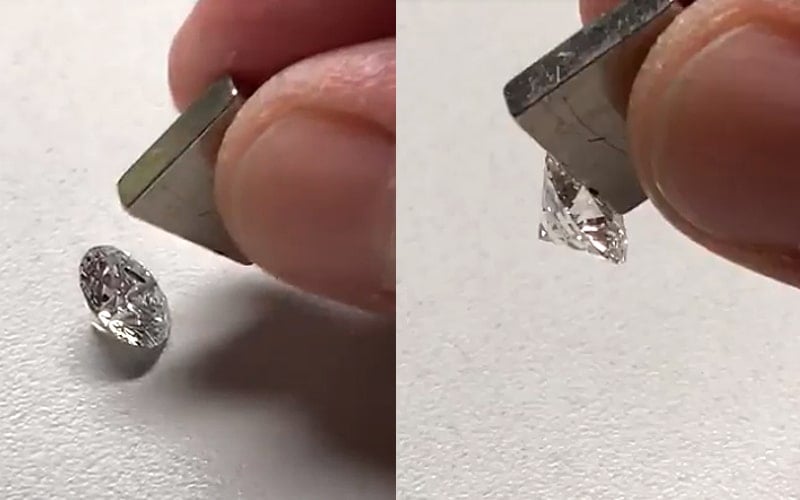Lab-grown diamonds have become a popular alternative to natural diamonds due to their ethical sourcing, affordability, and identical chemical composition. One of the most common concerns among buyers is the presence of inclusions in lab created diamonds. These inclusions in lab-created diamonds can affect the stone’s clarity, brilliance, and overall value. Understanding inclusions in lab-created diamonds helps buyers make informed decisions when purchasing lab-grown diamonds.
Table of Contents
What Are Inclusions in Lab-Created Diamonds?
Inclusions in lab-created diamonds refer to internal flaws that occur during the diamond growth process. Just like natural diamonds, lab-grown diamonds can develop imperfections due to temperature fluctuations, pressure changes, and residual metallic elements. These inclusions in lab-created diamonds may appear as tiny crystals, feathers, clouds, or graining lines within the stone. The presence of inclusions in lab-created diamonds does not always diminish their beauty, but it does play a role in determining the quality of lab-grown diamonds.
Types of Inclusions in Lab-Created Diamonds
There are various types of inclusions in lab-created diamonds that buyers should be aware of. Metallic inclusions in lab-created diamonds result from the high-pressure, high-temperature (HPHT) growth process, where metal flux is used to facilitate diamond formation. Needle-like inclusions in lab-created diamonds are commonly found in chemical vapor deposition (CVD) diamonds, often appearing as fine, thread-like structures. Cloud inclusions in lab-created diamonds consist of a cluster of microscopic particles that can slightly affect transparency. Feather inclusions in lab-created diamonds resemble tiny cracks and may impact durability if located near the surface. Understanding these inclusions in lab-created diamonds ensures that buyers can select lab-grown diamonds that meet their preferences.
How Inclusions in Lab-Created Diamonds Affect Quality
Inclusions in lab-created diamonds influence clarity grading, which is a crucial factor in assessing the quality of lab-grown diamonds. Clarity is determined based on the number, size, location, and visibility of inclusions in lab-created diamonds. While most inclusions in lab-created diamonds are microscopic and do not affect visual appeal, larger inclusions can impact light performance and sparkle. High-quality lab-grown diamonds typically have fewer inclusions in lab-created diamonds, resulting in superior brilliance and transparency. Buyers looking for premium lab-grown diamonds should opt for stones with minimal inclusions in lab-created diamonds to ensure optimal clarity.
Comparing Inclusions in Lab-Created Diamonds vs. Natural Diamonds
Both natural and lab-grown diamonds contain inclusions, but the nature of inclusions in lab-created diamonds differs from those in natural stones. Natural diamonds develop inclusions due to geological processes, whereas inclusions in lab-created diamonds form due to controlled laboratory conditions. One key distinction is that inclusions in lab-created diamonds often contain metallic traces, which can be detected using specialized tools. Additionally, inclusions in lab-created diamonds tend to be more uniform compared to the irregular inclusions found in natural diamonds. Despite these differences, inclusions in lab-created diamonds do not compromise the overall durability and longevity of lab-grown diamonds.
Minimizing the Impact of Inclusions in Lab-Created Diamonds
Buyers concerned about inclusions in lab-created diamonds can take steps to minimize their impact. Selecting lab-grown diamonds with a higher clarity grade ensures that inclusions in lab-created diamonds remain less noticeable. Professional jewelers can also assist in positioning inclusions in lab-created diamonds in a way that reduces visibility when setting the stone. Some inclusions in lab grown diamonds are only visible under magnification, so evaluating the diamond in natural light helps buyers assess how inclusions in lab-created diamonds appear to the naked eye. By carefully choosing lab-grown diamonds with fewer inclusions in lab-created diamonds, buyers can enjoy beautiful, high-quality stones.
Certification and Grading of Inclusions in Lab-Created Diamonds
Reputable gemological laboratories provide certification that evaluates inclusions in lab-created diamonds based on standardized grading criteria. Certificates from organizations like the Gemological Institute of America (GIA) and the International Gemological Institute (IGI) outline clarity characteristics and the presence of inclusions in lab-created diamonds. Buyers should always review these certificates to understand the clarity grade and how inclusions in lab-created diamonds may affect the stone’s appearance. Proper certification ensures transparency and guarantees the authenticity of lab-grown diamonds.
Why Inclusions in Lab-Created Diamonds Matter to Buyers
Understanding inclusions in lab-created diamonds is essential for making informed purchasing decisions. While inclusions in lab-created diamonds do not always diminish beauty, they influence price, clarity, and overall value. Some buyers may prefer lab-grown diamonds with fewer inclusions in lab-created diamonds for a flawless look, while others prioritize affordability and are willing to accept minor inclusions. Ultimately, inclusions in lab-created diamonds are a natural part of the diamond-growing process and should be considered when selecting the perfect lab-grown diamonds.
Conclusion
Inclusions in lab-created diamonds are an important factor in determining the clarity and quality of lab-grown diamonds. By understanding the types, impact, and grading of inclusions in lab-created diamonds, buyers can make educated choices when selecting lab-grown diamonds. Whether prioritizing clarity or value, inclusions in lab-created diamonds should be carefully evaluated to ensure satisfaction with the final purchase. Lab-grown diamonds remain a stunning and ethical choice, and inclusions in lab-created diamonds are just one aspect of their unique characteristics.

